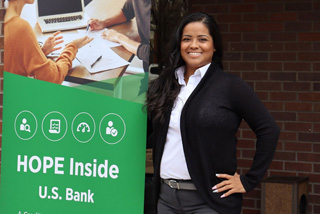
Tips for handling rising costs from an Operation HOPE Financial Wellbeing coach

What to do with your tax refund or bonus

Learn which type of account to use for what purpose when trying to achieve your financial goals.
Four months. 40 years. No matter how long you’ve been managing your own money, you can always learn new ways to practice smart spending and saving.
What is a checking account?
Your checking account is your primary tool to use to pay day-to-day expenses. It lets you accept money — and then spend that money to meet your everyday expense needs.
Your checking account safely holds the funds you need. When you pay for groceries, gas, and monthly bills, it’s common to use money from your checking account.
What is a savings account?
If a checking account can be viewed as a primary tool to use to pay day-to-day expenses, a savings account can be thought of as a "piggy bank."
The primary purpose of a savings account is to protect your money for future use. By design, it limits how frequently you can transfer funds in and out. So you’re not tempted to use it for day-to-day spending.
A savings account is a financial tool with a couple of unique features. The first is that limitation on transfers. The second? Interest. A savings account offers you an interest rate on the money in your account to help your savings grow.
What is interest, and how can it help me save over time?
Some savings accounts offer a small financial return in exchange for keeping your money in that account. This return (a.k.a., interest) gets calculated as a percentage of the balance you maintain in the account.
The percentage varies depending on the type of account you hold. Other “interest-bearing” financial tools, such as a certificate of deposit (CD) or money market account offer potentially higher returns. But some of these accounts may also charge for early withdrawal.
So a savings account gives you the best of both worlds: You get a small return on your investment. You also have the flexibility to make withdrawals or transfers.
What is the best savings account for me?
Some savings accounts will suit your needs better than others. Asking these questions can help you find a good fit.
What is the best checking account for me?
You’ll want to be as choosy with your checking account as you are with your savings account. In general, make sure you get a clear picture of the accounts that meet your financial needs. Pay special attention to the account’s overdraft policy. These questions can help you decide which account makes the most sense for your needs before you open a checking account.
How can I make my checking and savings accounts work together for my benefit?
Checking and savings accounts offer more than secure storage for your hard-earned income. Used together, they can help you develop a solid financial health plan.
You may want to consider setting up an automated savings option to help you prepare for your future. For example, say you deposit $1,000 from your paycheck into your checking account. You can earmark $200 of that so it gets automatically moved into your savings account. You control the amount, the frequency, the day of the week for the transfer. And you can change these settings as your life circumstances change.
Auto transfers are a great tool for holding yourself accountable to a higher level of financial preparedness.
For even more banking benefits, learn about the U.S. Bank Smart Rewards Program.
Related content


